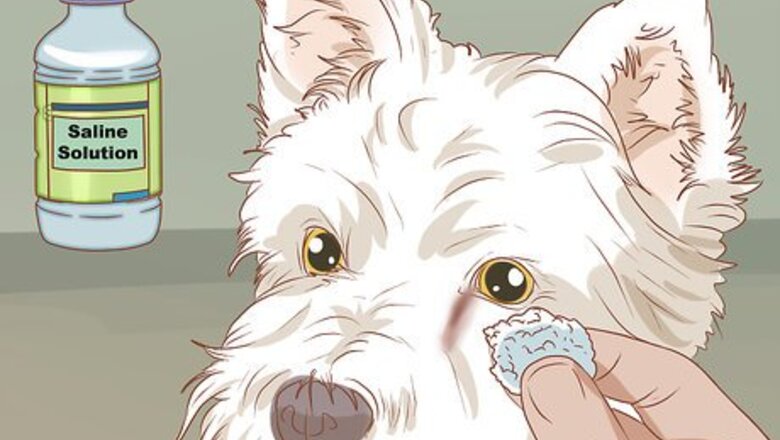
views
Removing Tear Stains
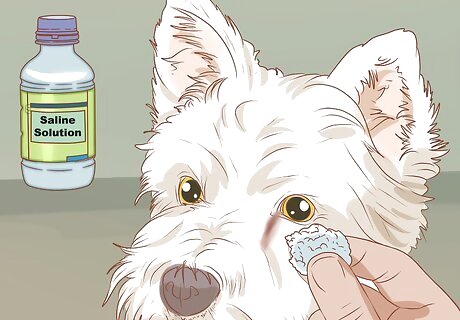
Wipe the stains with a cotton ball dipped in saline solution. Dampen a cotton ball with a mild saline eye wash solution labeled for pets. Then carefully rub the stained fur beneath one eye and along the side of your dog's nose with the cotton ball. Use separate cotton balls for each eye to avoid spread a potential eye infection. Look for saline eye wash products online or at a pet store.Safety precaution: Be sure not to rub the eye itself with the cotton ball. Avoid applying solutions, ointments, or any other products directly to your dog’s eyes without a vet’s approval.
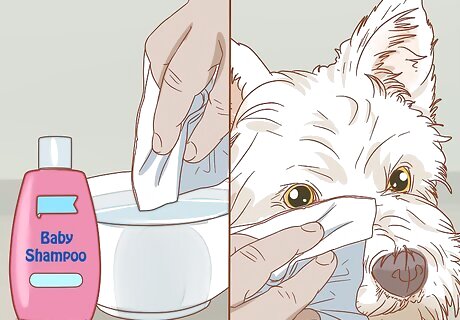
Wash around your dog’s eyes with pet or baby shampoo. If saline didn’t do the trick, dampen a clean washcloth with warm water, then apply a small dab of tearless shampoo onto it. Lather the shampoo and gently scrub the stained fur. Rinse the washcloth thoroughly to remove suds, then wipe your dog's face until you’ve wash away all shampoo residue. Use opposite ends of the washcloth on each eye to avoid spreading a possible eye infection. Be sure to use a shampoo labeled for dogs or a mild, tearless baby shampoo. Do not use regular shampoo.
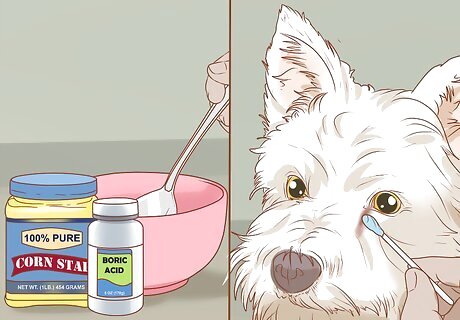
Try applying a cornstarch and boric acid mixture to the stain. For stubborn tear stains, combine equal parts of cornstarch and boric acid, along with enough water to make a thick paste, then set the mixture aside. Dampen your dog’s eyes with a clean washcloth, and use a cotton swab or ball to carefully apply the boric acid mixture to the stained area. Be sure not to get the mixture in your dog’s eyes; just apply it to the stained fur. If your dog tolerates it without pawing at its eyes, let the mixture sit for a couple of minutes. Then thoroughly wipe the area with a damp washcloth. If you have any leftover mixture, refrigerate it and store it for up to a week. If you’d like, make a batch large enough to last you the full week.
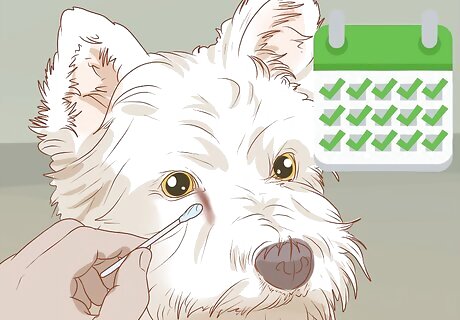
Clean your dog’s eyes daily, and expect to see results in a few weeks. Saline, pet shampoo, or boric acid and cornstarch may not work after a single use, but you should still keep trying. If you don't see immediate results, clean your dog's eyes daily and do your best to keep its eyes dry. You should see results within a month. Boric acid will lighten fur, so it's your strongest method. However, saline or tearless shampoo should work over time if you don't have boric acid on hand. Try to be patient. Controlling tear duct stains may take time, but making sure your pet is happy, healthy, and looking its best is well worth the effort.
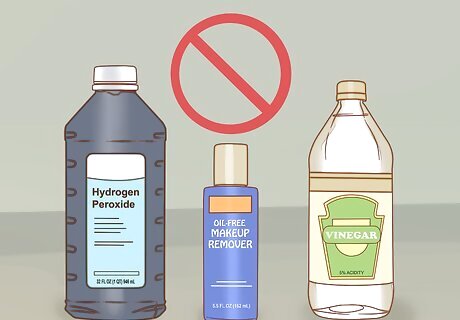
Avoid using hydrogen peroxide, vinegar, or makeup remover. You may come across sources that advise using these products, but steer clear. They can irritate your dog’s eyes, which will only make matters worse. Additionally, never use essential oils or herbal products on your dog. Many essential oils and herbs can make dogs sick.
Preventing Stains
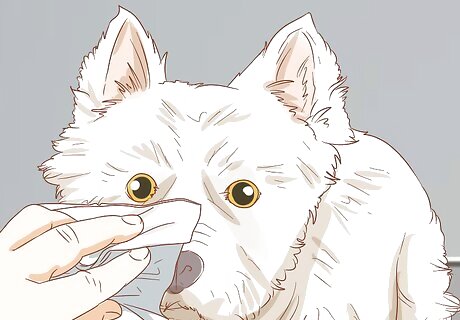
Dry your dog’s facial fur at least 2 to 3 times a day. Do your best to keep the fur around your dog’s eyes and mouth dry at all times. Use a clean, dry washcloth to blot up tears whenever you notice its eyes are getting wet or gunky. Saliva can cause brown staining in white dogs, so wipe your pet's mouth, too. You may need a fine-toothed comb to remove caked-up debris. For the best shot at controlling moisture, try to dry your dog’s eyes and mouth right after it drinks water and eats.
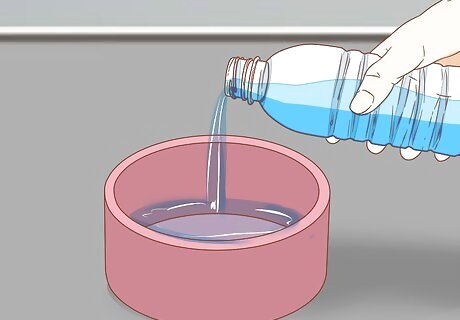
Give your dog bottled or purified water instead of tap. The minerals in tap water may worsen staining so, if necessary, switch your dog’s water. For the most cost-effective option, invest in a faucet-attached or pitcher water filter.Tip: If you use plastic water bowls, switch to metal. Plastic bowls can harbor bacteria, which can lead to eye irritation or infections.
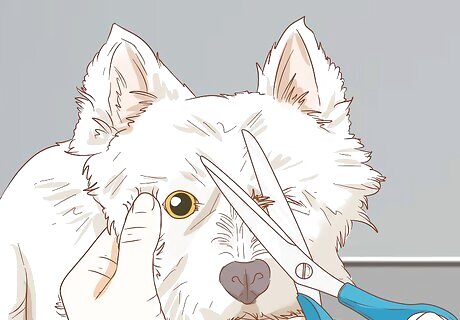
Trim the fur around your dog’s eyes regularly. If possible, take your dog to the groomer every 4 to 6 weeks, or as often as recommended for its breed. Between grooming sessions, carefully, snip long fur around its eyes to keep staining in check. Offer lots of praise and pea-sized treats to get your dog comfortable with grooming sessions. If it won’t sit still, carefully drape your body over it and secure it with your non-dominant arm. If necessary, recruit a helper to keep it still so you can safely trim its eyes. It’s wise to groom your dog after a brisk walk or playtime so it’s tired. If your dog yelps, gets aggressive, or otherwise seems stressed, give it a break. Don’t force it or handle it roughly if it’s anxious. You’re better off using treats and praise to encourage your dog to enjoy grooming.
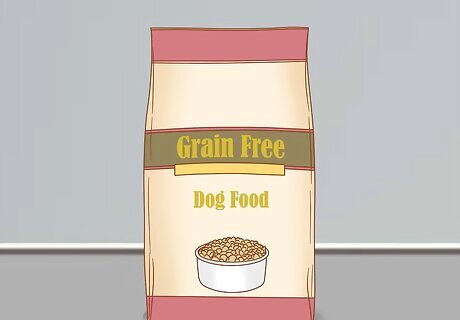
Consider switching to grain-free dog food. Although grain-free diets are more of a trend than something beneficial for your dog that is based on science, it’s possible some dogs have allergies to grains and additives found in many commercial dog foods. In addition to tear stains, excessive scratching and licking or visible skin irritation may indicate an allergy. If you suspect your dog is having allergic reactions, ask its vet if they recommend switching to a grain-free option. Switch your pet’s food gradually. Starting by feeding it a half-and-half mixture of the old and new food, then decrease the amount of old food over the course of several days. Keep in mind that there may be negative health effects from putting your dog on a grain-free diet. Be cautious and talk with your dog’s veterinarian before making the switch.

Try using apple cider vinegar, buttermilk powder, or probiotic enzymes. Some people report success with adding 1 teaspoon (5 mL) of natural additives to each of their pet's meals. You can find apple cider vinegar and buttermilk powder at the grocery store. Look for probiotic enzymes for tear stain reduction online and at pet stores. Use just 1 natural additive; don't add all 3 to your dog's food. While some people claim these methods work, it’s always best to check with a vet before adding anything to your pet's food or making changes to its diet.
Consulting a Vet
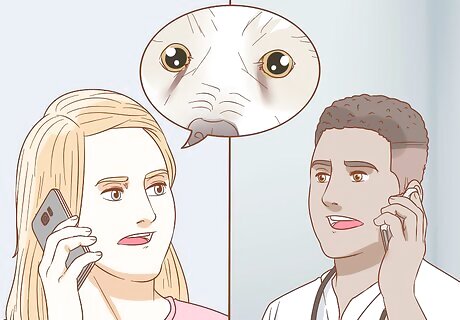
Call the vet if tear staining is excessive or abnormal. If you think something’s wrong, bring your dog to the vet for a checkup. Tear stains are normal, especially in dogs with light coats, but symptoms that are severe or occur suddenly may require professional care. For instance, white-coated, short-nosed breeds such as Bichon Frise and Maltese are prone to ingrown eyelashes, blocked tear ducts, infections, and other eye disorders.When to call the vet: Concerning signs include excessive tearing that develops suddenly, frequent blinking, redness, swelling, and discharge. Stay on the safe side and have your pet checked out if you notice any of these symptoms.
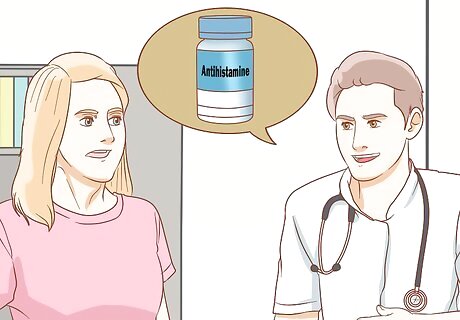
Ask the vet if they recommend allergy medication. Allergies are a common cause of excessive tearing, so the vet may recommend a prescription or over-the-counter oral antihistamine. To give your dog a pill, simply place the prescribed dose in a treat or pill pocket, then offer it to your pup. Allergies may be the culprit if you notice your dog seems to tear up seasonally or in certain situations. When you notice excessive tearing, try to identify any potential allergens that could be causing the problem. Switching your dog’s food, using air purifiers in your home, and keeping your dog away from smoke and other irritants may help solve the issue.
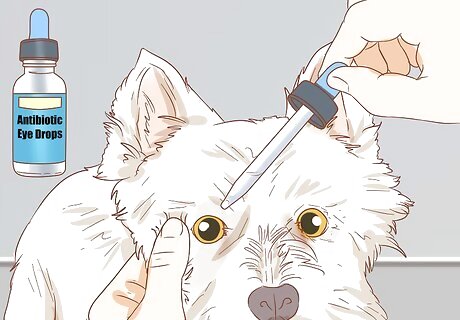
Apply a prescription ointment as directed by the vet. If the vet determines there’s an infection, you’ll need to administer antibiotic eye drops or ointment 3 to 4 times a day. Have a helper gently restrain your dog, carefully hold its eyelids open, then squeeze the prescribed amount of medication into the inside pocket of the lower lid. Allow your dog to blink, which will spread the medication over the eye. Then, if necessary, repeat the steps on the other side. Take care not to touch the tip of the applicator to your dog’s eyes. Be sure to give your pooch plenty of praise and treats to help make the process less stressful. Never apply ointments, drops, or other medications to your dog’s eyes without consulting a vet.
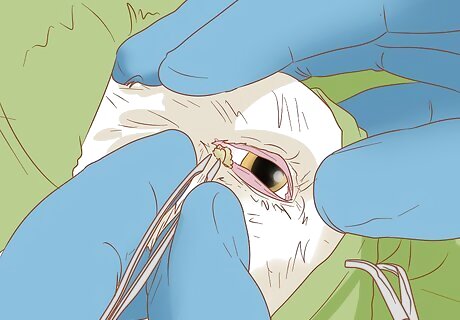
Discuss surgical options if your dog has ingrown eyelashes. Most of the time, tearing and tear stains are nothing to worry about. However, if your dog is diagnosed with ingrown eyelashes, it’ll need corrective surgery. Treatment involves removing small pieces of skin so your dog’s eyelids can sit against the eye without rolling inward and irritating the cornea. At least 1 to 2 minor surgeries may be required, but most dogs recover without any issues and enjoy full lives free of discomfort. After eyelid surgery, your pooch will need to wear an E-collar for 2 weeks, and you may need to apply drops or ointment to its eyes to prevent infection. If your dog is diagnosed with ingrown eyelashes or inward-turning eyelids, it’s important to have the issue corrected. Eventually, the condition could lead to blindness. Typically, treatment costs $500 for 1 eye and up to $1500 (U.S.) for both eyes. If you need help covering the costs, set up a budget-friendly payment plan with the vet, look online for charitable organizations, or launch a crowdfunding campaign.



















Comments
0 comment